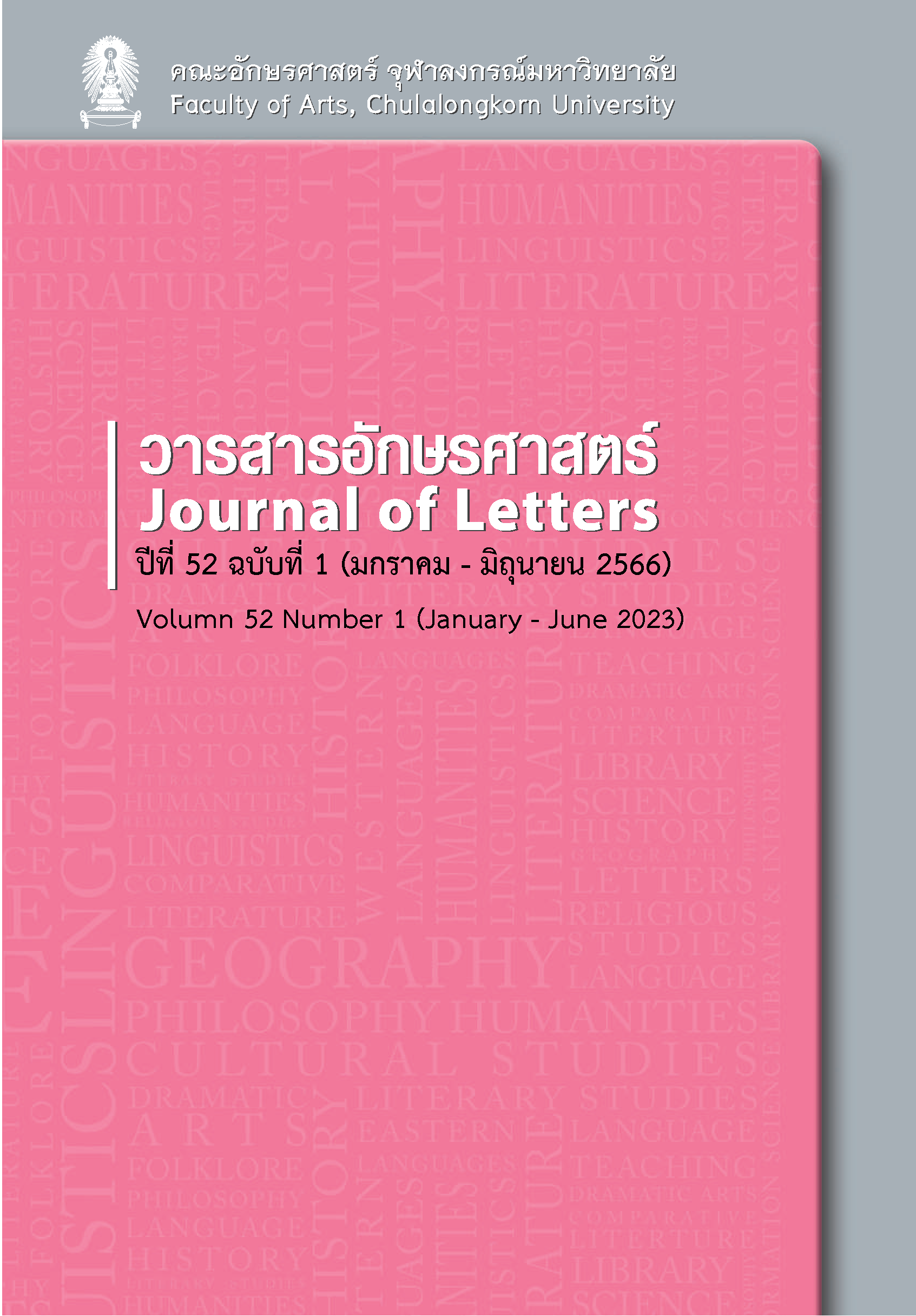ความเชื่อเรื่องภูเขาศักดิ์สิทธิ์และพระสูตรจำแลงร่าง ในพุทธประวัติญี่ปุ่น “ฌะกะโนะฮนจิ”
คำสำคัญ:
พุทธประวัติญี่ปุ่น, ฌะกะโนะฮนจิ, สัทธรรมปุณฑริกสูตร, ภูเขา, ยุคกลางบทคัดย่อ
บทความนี้เป็นผลวิจัยส่วนหนึ่งจากโครงการวิจัย “อ่านวรรณกรรมพุทธประวัติญี่ปุ่น: กรณีศึกษาเรื่อง Shaka no honji”
โดยมีวัตถุประสงค์เพื่อศึกษาทำความเข้าใจ วิเคราะห์ลักษณะเด่นของวรรณกรรมพุทธประวัติญี่ปุ่น และวิเคราะห์คติความเชื่อที่สะท้อนให้เห็นในวรรณกรรมพุทธประวัตินั้น บทความนี้นำเสนอคติความเชื่อเกี่ยวกับการจำแลงร่างของพระสูตรที่ปรากฏเป็นผู้ช่วยของเจ้าชายสิทธัตถะหรือพระโคตมพุทธเจ้า และคติความเชื่อเรื่องภูเขาศักดิ์สิทธิ์ในวรรณกรรมพุทธประวัติเรื่อง “ฌะกะโนะฮนจิ” ผลการศึกษาสรุปได้ว่าผู้ช่วยของเจ้าชายสิทธัตถะหรือพระโคตมพุทธเจ้ามีหลากหลาย พบลักษณะเด่นประการหนึ่งคือพระสัทธรรมปุณฑริกสูตรจำแลงร่างเป็นผู้ช่วยของเจ้าชายสิทธัตถะ สะท้อนคติความเชื่อว่าพระสูตรนี้เป็นเสมือนตัวแทนของพระพุทธเจ้า มีความศักดิ์สิทธิ์แม้กระทั่งตัวอักษร การที่พระสูตรจำแลงร่างเข้าช่วยเหลือตัวละคร
คงสืบเนื่องมาจากคติดังกล่าวและยังเป็นการนำองค์ประกอบในวรรณกรรมพุทธญี่ปุ่นมาผลิตซ้ำ ส่วนคติเรื่องภูเขาศักดิ์สิทธิ์พบว่าใช้ภูเขาเป็นฉากหลายเหตุการณ์ในเรื่อง โดยในประเทศญี่ปุ่น ภูเขาถือเป็นพื้นที่ศักดิ์สิทธิ์นับแต่ยุคโบราณ เป็นพื้นที่เชื่อมโยงสู่อีกมิติ โลกหลังความตายหรือแดนพุทธเกษตร เป็นสถานที่ฝึกตนเพื่อไปสู่สถานะที่สูงขึ้น ลักษณะเช่นนี้คงส่งผลให้การรับองค์ประกอบที่ฉากหลังในเรื่องพุทธประวัติเป็นภูเขาไม่ขัดแย้งกับคติความเชื่อดังกล่าวของญี่ปุ่น
เอกสารอ้างอิง
ภาษาต่างประเทศ
Asada, T. 浅田徹. (2016). Shosha to dokuju: Hokekyou no moji to koe書写と読誦-法華経の文字と声 [Transcription and recitation: Characters and sounds of the Lotus Sutra]. In T. Asada (Ed.), Nihonkasuru hokekyou日本化する法華経 [The Japanization of the Lotus Sutra] (pp. 86-98). Benseishuppan.
Dake, M. 嵩満也. (2017). Indo, chuugoku, nihon joudokyou niokeru amidabutsushinkou to joudokan no shisouteki tenkaiインド・中国・日本浄土教における阿弥陀仏信仰と浄土観の思想的展開 [The development of the idea of Amida Buddha and the pure land in India, China, and Japan]. Ryuukokudaigakukokusaishakaibunkakenkyuushokiyou龍谷大学国際社会文化研究所紀要 [Journal of the Socio-Cultural Research Institute, Ryukoku University: Society and Culture], 19, 65-75.
Higashidate, S. 東舘紹見. (2009). “Hokekyou” juyou toshite no kannonshinkou to sono keitai 『法華経』受容としての観音信仰とその形態 [The Japanese faith in Kannon as an aspect of the acceptance of the Lotus Sutra]. Shuukyoukenkyuu宗教研究 [Journal of Religious Studies], 82(4), 949-950.
Inagi, S. 稲城選恵. (1962). Houzoubosatsuron: Sono sonzai riyuu wo chuushin toshite 法蔵菩薩論:その存在理由を中心として [The study of Hozoubosatsu: Focusing on His Raison d'être]. Hyakkaen.
Ishii, K. 石井公成. (2016). “Hokekyou” to geinou no musubitsuki: Shoutokutaishiden, biwahoushi, ennen『法華経』と芸能の結びつき-聖徳太子伝・琵琶法師・延年 [The relationship between the Lotus Sutra and entertainment: The story of Prince Shoutoku, Biwa Minstrels and Buddhist entertainment performed by monks and pages]. In T. Asada (Ed.), Nihonkasuru hokekyou日本化する法華経 [The Japanization of the Lotus Sutra] (pp. 12-23). Benseishuppan.
Kobayashi, Y. 小林芳規編 (Ed.). (1975). Hokkehyakuzakikigakishou sousakuin法華百座聞書抄総索引 [Index of “Hokkehyakuzakikigakishou”]. Musashinoshoin.
Kondou, Y. 近藤譲. (2008). Kodai no shitennou shinkou to kyoukaininshiki古代の四天王信仰と境界認識 [Shitennou belief and boundary recognition of ancient times]. Bukkyoudaigaku shuukyoubunka myujiamu kenkyuu kiyou佛教大学宗教文化ミュージアム研究紀要 [Journal of Bukkyo University Religion Culture Museum], 5, 5-23.
Matsushita, F. 松下藤子. (2015). Nichirenshounin no shijoushikyouka: Nittenshishinkou wo chuushin toshite日蓮聖人の四条氏教化:日天子信仰を中心として [Nichiren’s preaching for Shijoushi: Focusing on the belief of Nittenshi]. Nichirenkyougakukenkyuushokiyou日蓮教学研究所紀要 [Journal of Nichiren Buddhism], 43, 118-128.
Miyake, H. 宮家準. (2022). Reizan to nihonjin 霊山と日本人 [Sacred mountains and Japanese people]. Koudansha.
Motoi, M. 本井牧子. (2013). “Shaka no honji” to sono engen: “Hokekyou” no sennin kyuuji wo meguru 『釈迦の本地』とその淵源-『法華経』の仙人給仕をめぐる- [“Shaka no honji” and its origin: Focusing on the episode of serving the ascetic in the Lotus Sutra]. In T. Ishikawa (ed), Chuusei no monogatari to kaiga 中世の物語と絵画 [Literatures and paintings in Medieval period] (pp. 215-243). Chikurinsha.
Motoi, M. 本井牧子. (2016). “Shaka no honji” no shohon『釈迦の本地』の諸本 [Various books of “Shaka no honji”]. Kyoutodaigakukokubungakuronsou京都大学國文學論叢 [Journal of Letters, Kyoto University], 35, 47-69.
Motoi, M. 本井牧子. (2017). “Shaka no honji” to sono tenkai: Nehan no bamen wo tancho toshite『釈迦の本地』とその展開-涅槃の場面を端緒として [“Shaka no honji” and its development: From the scene of nirvana]. In K. Komine (Ed.), Higashi ajia no butsudenbungaku東アジアの仏伝文学 [Narratives of the life of the Buddha in Eastern Asia] (pp. 494-516). Benseishuppan.
Sahara, S. 佐原作美. (1970). Konjakumonogatarishuu niokeru kannonshinkou今昔物語集における観音信仰 [The belief of Avalokitesvara in “Konjakumonogatarishuu”]. Komazawakokubun駒澤國文 [Journal of Letters, Komazawa], 8, 37-47.
Tantisuk, N. (2022, November 17). Reading Japanese narratives of the life of the Buddha: A case study of Shaka no honji (the story of Sakyamuni) [Paper presentation]. The 16th JSAT Conference (Hybrid) “Think Global Live Local for Sustainable Multi-cultural Society”, Thailand.
Tokieda, T. 時枝務. (2016). Kyouzuka ni mainousareta hokekyou経塚に埋納された法華経 [The Lotus Sutra in Sutra mound]. In T. Asada (Ed.), Nihonkasuru hokekyou日本化する法華経 [The Japanization of the Lotus Sutra] (pp. 190-200). Benseishuppan.
Tokuda, K. 徳田和夫編 (Ed.). (2002). Otogizoushijitenお伽草子事典 [Encyclopedia of “Otogizoushi”]. Toukyoudoushuppan.
Uryuu, N. 瓜生中. (2020). Yoku wakaru sangakushinkouよくわかる山岳信仰 [The belief of sacred mountains]. KADOKAWA.
Yamada, M. 山田美季. (2018). Nihon no jakikan no keisei to shitennou shinkou日本の「邪鬼」観の形成と四天王信仰 [The formation of Jaki and the Shitenno belief]. Nihonshuukyoubunkashikenkyuu日本宗教文化史研究 [Journal of Japanese Religious and Cultural History], 22(1), 21-40.
Yamamoto, T. 山本勉. (1997). Nihon no bijutsu dai 374 gou dainichinyoraizou日本の美術 第374号 大日如来像 [Japanese art No. 374 the image of Vairocana]. Shibundou.
Yokoyama, S. 横山重編 (Ed). (1962). Muromachijidai monogatarishuu daiyon室町時代物語集 第四 [Tales from Muromachi period Vol. 4]. Inoueshobou.
Yoshida, Y. 吉田唯. (2020). Shimbutsushuugou no shuhou: Chuusei shinwa kara kinsei shinwa e神仏習合の手法:中世神話から近世神話へ [The way of “Shimbutsushuugou”: From Medieval mythology to pre-modern mythology]. Shintensha.
ดาวน์โหลด
เผยแพร่แล้ว
รูปแบบการอ้างอิง
ฉบับ
ประเภทบทความ
สัญญาอนุญาต

อนุญาตภายใต้เงื่อนไข Creative Commons Attribution-NonCommercial-NoDerivatives 4.0 International License.
การป้องกันปัญหาด้านลิขสิทธิ์และการคัดลอกผลงาน
ผู้เขียนบทความมีหน้าที่ในการขออนุญาตใช้วัสดุที่มีลิขสิทธิ์คุ้มครองจากเจ้าของลิขสิทธิ์ ผู้เขียนบทความมีความรับผิดชอบที่จะต้องปฏิบัติตามกฎหมายในการคัดลอกและทำสำเนาวัสดุที่มีลิขสิทธิ์อย่างเคร่งครัด การคัดลอกข้อความและการกล่าวพาดพิงถึงเนื้อหาจากวัสดุตีพิมพ์อื่น ต้องมีการอ้างอิงแหล่งที่มากำกับและระบุแหล่งที่มาให้ชัดเจนในส่วนบรรณานุกรม การคัดลอกข้อความหรือเนื้อหาจากแหล่งอื่นโดยไม่มีการอ้างอิงถือเป็นการละเมิดจริยธรรมทางวิชาการที่ร้ายแรง และเข้าข่ายการละเมิดลิขสิทธิ์ตามพระราชบัญญัติลิขสิทธิ์ พ.ศ. 2537 หากมีการฟ้องร้องดำเนินคดีใด ๆ เกิดขึ้น ผู้เขียนบทความมีความรับผิดชอบทางกฎหมายแต่เพียงผู้เดียว



